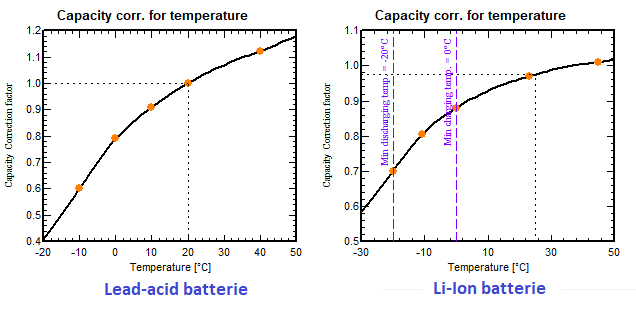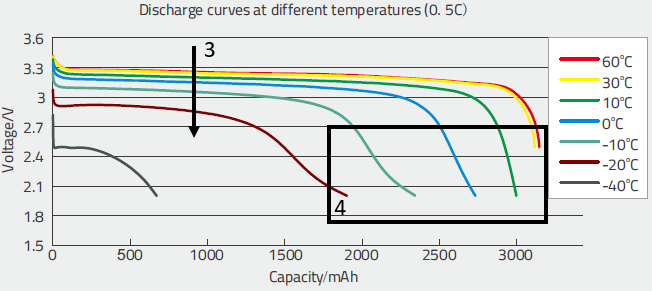Capacity as function of the Temperature
In all batteries, the capacity is reducing when the temperature decreases.
Lead-acid batteries
For the lead-acid batteries, PVsyst proposes a default capacity derate function (profile with 5 points) which should not be so different from battery to battery. This was established during private discussions with a manufacturer, but is never mentioned on the datasheets.
Operating temperature range
The lower possible temperature is related to the freezing of the electrolyte, which depends on the state of charge. Indeed the acid concentration decreases the freezing temperature. Therefore an empty battery is more sensitive to frost damage. Please also notice that high temperatures have a huge effect on the lifetime of the Lead-acid batteries.
Li-ion batteries
The temperature dependency is described in the same way, with a 5-points profile. The behaviors is very similar to the lead-acid batteries, but the performance at low temperatures is slightly better (-20% at -10°C, when it is -40% for lead-acid)
Here we have evaluated this dependency using the detailed capacity curves given by some few cell manufacturers.
Operating temperatures
Most of the Li-Ion battery datasheets specify a minimum operating temperature higher for charging than for discharging. This is often 0°C when charging, and -10°C when discharging. But this may be lower. These minimum values are specified as parameters in the battery definition.
For a solar static system, the battery temperature is usually not very significant: the battery bank is indoor at a rather constant temperature. And the temperature may increase during intensive charge/discharge periods (due to internal resistance). This would not be the case, for example for an electric vehicle, which is charged indoor, and discharged at external temperature. Electric cars sometimes heat-up the battery bank by low temperatures, which means an additional electric consumption.
During the simulation, you have the opportunity of defining the battery temperature, as "Fixed", "Fixed by month", "Ambient temperature" or "Average between Ambient and a fixed value".

